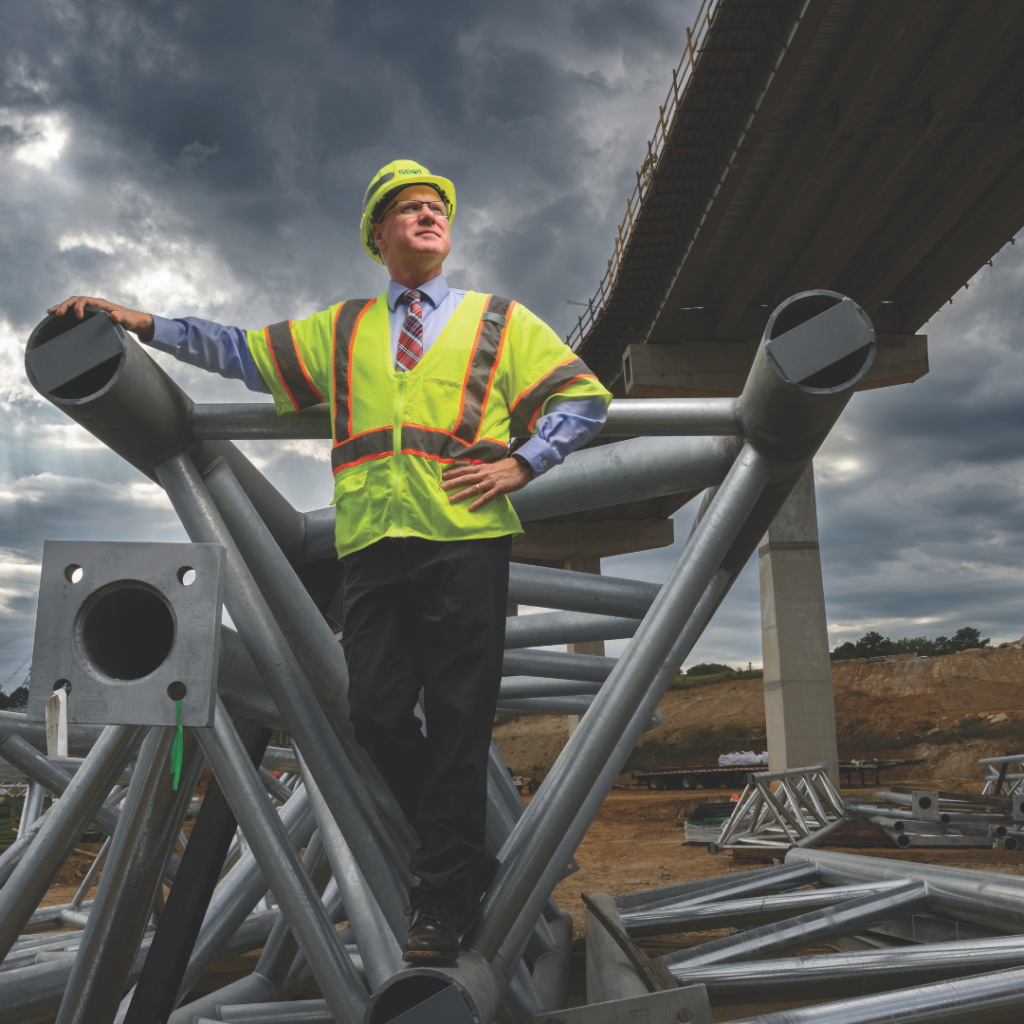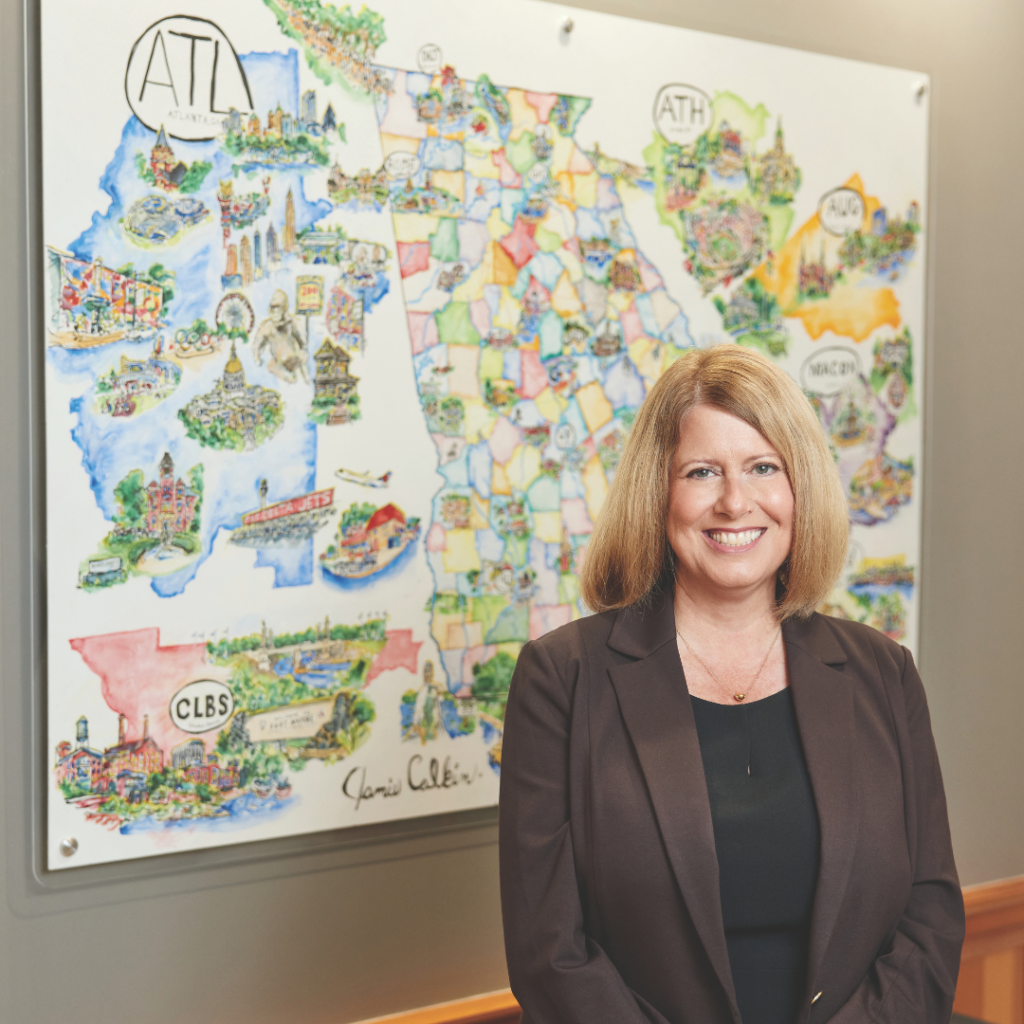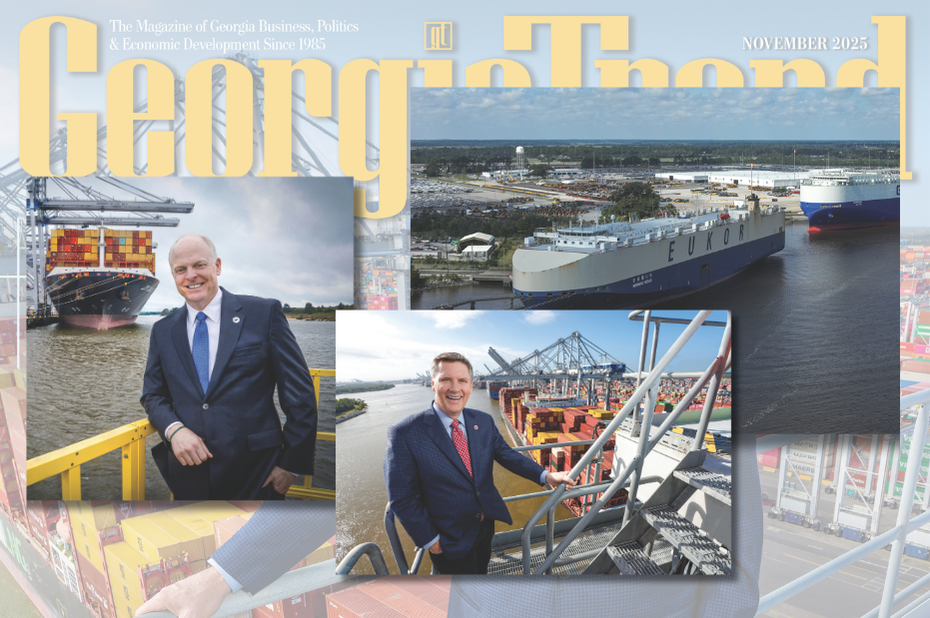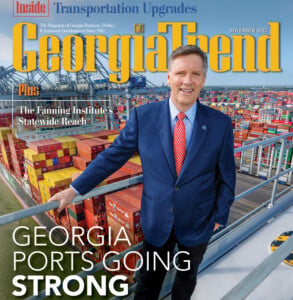Mayor Roundtable
A conversation with various mayors about issues facing the state today.

Tackling Problems: Madison Mayor Fred Perriman, center, discusses municipal issues with Lovejoy Mayor Marci Fluellyn, left, and Fitzgerald Mayor Jason Holt, right. Photo credit: Frank Fortune
Georgia Trend convened three groups of mayors at the Georgia Municipal Association Annual Conference in Savannah this summer to discuss topics of importance to their communities and to seek peer advice on potential solutions. The three groups were divided according to city size – small, medium and large – and mayors were selected by Georgia Trend and the GMA to participate. We hope you enjoy the exchanges and ideas that emerged from the experience.

Handling Challenges: (Clockwise from top left) Fitzgerald Mayor Jason Holt, Madison Mayor Fred Perriman, Lovejoy Mayor Marci Fluellyn and Young Harris Mayor Andrea Gibby. Photo credit: Frank Fortune
The small cities roundtable consisted of Mayor Marci Fluellyn, Lovejoy; Mayor Fred Perriman, Madison (2024 GMA President); Mayor Jason Holt, Fitzgerald; and Mayor Andrea Gibby, Young Harris. Following are highlights from the conversation we had that day.
Infrastructure
Holt: [In a conversation about] social services, I can’t let this opportunity go without talking about the mental health crisis that we have all over the state, but in rural Georgia, in my community, it then becomes a police issue because we don’t know how to deal with it. There aren’t mental health services to treat our folks. So they wind up calling 911. We have trained [our police] in crisis management de-escalation, which has helped. We need more. But when [people are] taken to our emergency room, they become a problem for our rural hospital, which is barely hanging on by a thread. The soft services, social service infrastructure, I think, really needs attention in our part of state.
Fitzgerald is an old city. We have terracotta pipes downtown; they’re beginning to crumble. We’re in South Central Georgia. Ben Hill County is on the aquifer, so we have plenty of water. The delivery system needs some work. I would say the same for natural gas.
Gibby: One of the challenges we’re running into now is [since] COVID, people have found the mountains, and that’s fine. I mean, I love for people to find us, but we are going to have to figure out how to rise to the challenge of expanding our lines – water, sewer – and roads to provide for new residents. I will say that one of the big problems when you’re upgrading is there’s so much paperwork, and it just takes such a long time.
Fluellyn: The railroad runs right through our downtown district, and it was laid many years ago, and the way it was put in created an issue for us. So we have transfer trucks that are stuck on the railroad quite often in our downtown, which creates a safety issue. And the population in Lovejoy is growing exponentially, so that creates a struggle for infrastructure to try and keep up.
Perriman: During the early years when the railroad put those tracks in town, it divided the community. You know, the Black community was on one side of the railroad track and the white community was on another side. … It really did sort of divide it, but we’re trying to come up with some ways now – how can we bridge this gap back?
Holt: My city doesn’t have the money for these heavier trucks that the General Assembly keeps permitting. They’re just ruining our streets.
Economic Development
Fluellyn: When you talk about economic development, sometimes it’s a nasty word, especially to your legacy residents, because for them, it means that the city is going to become cluttered and too uninviting. You do want [residents] to come back home after they graduate from college, and they have a different checklist, you know, the new generation.
Gibby: Finding some help with streamlining the [federal and state] grant processes would be an enormous relief for smaller communities. Since the [U.S.] Census is used [to determine] how much funding that we get, for cities that are booming, that last census does not represent what I’m currently serving. We still have to provide the services, so the funding is not matching up with what we need.
Federal Disaster Resources
Holt: We were hit with two of the hurricanes, not directly, but a big chunk of money that we spent we’re waiting on reimbursement for. We’re very concerned about the uncertainty in [Washington] on that funding. We have a very good relationship with our congressman. We have good relationships with both senators. Those phone calls don’t need to be made in the middle of the storm. You have to have those relationships ahead of time. You’ve got to lay that foundation before you need money.
Fluellyn: It would be wonderful to see corporations flip the coin on that one, because [they’re] living off the community and making a hefty revenue off the people in that area. So why not give back to the area? It may even turn into more revenue, because when community [members] see that [a business is] part of their future … they will patronize that business more often.

Growing Communities: Suwanee Mayor Jimmy Burnette, Carrollton Mayor Betty Cason, Cartersville Mayor Matt Santini and Union City Mayor Vince R. Williams. Photo credit: Frank Fortune
The medium-sized cities roundtable consisted of Mayor Matt Santini, Cartersville; Mayor Vince R. Williams, Union City; Mayor Jimmy Burnette, Suwanee; and Mayor Betty Cason, Carrollton. Following are highlights from their conversation.
Infrastructure
Cason: I have a great passion for mental health, because before I was mayor, I was probate court judge and have worked for a long time trying to get people educated on the importance of mental health and how it affects our communities. It doesn’t just affect the person – it affects the family; it affects the job market; it affects law enforcement. … We’ve worked hard, and we have our own mobile crisis unit to respond, which has been great. We have so many people now that have finally admitted that they have some kind of issue, and a lot of the issues are not just mental health; it’s not just one thing. Most of the time substance abuse comes from self-medicating.
Williams: We were named Georgia’s fastest growing city in 2023 [by IHeart Media] and last year, we were named the nation’s fourth-fastest growing [suburb by GOBankingRates]. So it’s important that we do have infrastructure in place, not just for moving and walking around and playing in the parks, but also for moving those transit opportunities [and] getting much needed trucks through our community; because we are a logistics city, we have a lot of truck traffic, but also those goods and services that the trucks are delivering.
Santini: If it’s a $350,000 townhome, that’s not affordable for somebody who has an entry level job, or somebody that’s not got a multiple income family. We’re trying to get a little more creative with our housing authority, to try to find some of those public-private partnerships or maybe do an income-based mixed development and try to make better use of the space that we have.
Burnette: I think one of the things that is certainly a big [issue] is the stormwater. Many of our subdivisions now are getting to be 20, 25 years old, and back in the day, we had to put in a stormwater utility fee there that we assess on everybody to help offset that. We [applied for] a [federal] grant [through Rep. Lucy McBath, that is in the processing phase.] Hopefully it’ll still be real – [it was] for about $900,000 that will help with our stormwater issues. If there [were] some [federal dollars] to go to the affordable housing issue, that would help communities and take off some of the burden from the developers. It would also help in a lot of areas where Suwanee still has a lot of septic tanks.
Williams: Something we are implementing at this very juncture is a lot of rewrites of our zoning code and our ordinances, because we are no longer the Mayberry-esque environment that many of our forefathers and mothers were accustomed to. We have this new advent of technology that is certainly infiltrating our communities, so we’ve got to make sure that zoning and ordinances are properly placed so that we can deal with this issue around housing.
But also, how do we place these other opportunities, such as data centers? You get the push from developers who say, ‘You’re making it too difficult on me.’ But you know, as growing communities, it’s not the time to lower your standards. We have asked our [county] school superintendent to serve on our [county’s] development authority board, so that you know what the impact is going to be, not only to the community, but [to] the school system too.
Cason: One issue that we face, because we have an aging population, is transportation within the city. Through our Three Rivers Commission, [Carroll County does] have some transportation. I think [the Carroll Connection roundtrip fare is] $6. But it only runs during certain hours, and it’s a funding issue. You can’t charge enough, because if you do that, it defeats the whole purpose of being able to transport your seniors. And of course, we have a lot of industry, and there are a lot of people that would work but don’t have transportation. So we are actually working with one of our local industries [that’s] looking at putting in a bus service to go to certain areas to pick people up, which would be great, but it’s a great liability for them.
Williams: We are working with MARTA right now as it relates to a couple of thoroughfares in our city where we will do bus rapid transit, not only to serve the workforce, but also everyday families to be able to get to doctors’ appointments, schools, grocery stores and different things like that.
Economic development
Santini: I’ve always been amazed at how many cities and counties don’t work together in a number of areas, including economic development. We created a joint development authority back in the early 2000s and have a joint industrial park, and it’s been a long road. There were some times we were wondering how we’re going to make payments on this thing. But now that park is full; we landed SK battery and Qcells, both green energy projects and two of the five largest in the history of the state. And then [Bartow County has] a sole commissioner. We’re the only state that allows it. [If] somebody’s in town, [and] the two of us are sitting in a room with them, we can move quickly.
Williams: When Shannon Mall became Atlanta Metro Studios, which is one of the most visited studios for post-production work, it also created a synergy for our existing businesses, our dry cleaners, our salons, our barbershops, our grocery stores. So it’s been a huge economic injection that certainly has benefited us. On our Innovation Corridor along Roosevelt Highway, we are attracting national distribution and e-commerce. I have four Amazon sites in the city. So we created 14,000 jobs over the past six years with those logistical opportunities, as well as the film industry.
Santini: You can’t forget the arts. We have a concert series, and the band that I booked that night ate at an Italian restaurant down the street. I knew the owner, and later when I went to settle up with them, she came up and hugged me, and she started crying. She said, ‘I came to work today, not knowing if I was able to keep my apartment, but because you had that show nearby, and we had such a large crowd, I can stay.’ The arts certainly have been an important part of economic development. A lot of people don’t look at it that way.
Shrinking Federal Resources
Cason: I think it’s going to impact everybody. Who can afford a $15 million water plant? I mean, you know you have to [have it]. It’s not just small and mid-sized cities. We may have to look at some special tax districts, not that we need them right now, but somewhere down the road.
Williams: We started the stormwater fee implementation probably about 12 years ago. And got pushback from some residents complaining about the $4 a month. And we had to explain to them what it’s for. When you think about the possible slicing or cutback of federal funding for huge infrastructure projects, anything that you need, we have to remember, and certainly our leaders in Washington must remember, that these are the citizens who pay into that. So they deserve to get that support back from the federal government. That’s our money, you know. So we’ve got to continue to voice that and let them know that.
Burnette: It is our money. We’re a Triple A bond-rated city. And [U.S. Rep. Andrew] Clyde was out to look at our park, and I said, you know, ‘You send us our money, we know how to spend it.’ And I reminded his staff the other day, when we were up there with [Georgia Municipal Association], I said, ‘Just remember to tell [the] congressman that gives us our money, that we know how to spend it.’ Right? That was one of the biggest pushbacks from a lot of federal leaders, suggesting that local leaders are using these federal funds and opportunities to be able to backfill our budgets. That is so far from the truth. Now, I can’t speak for everyone, but I do know that many of us, we have to turn in a balanced budget every year. We’re not like the federal government. We can’t print money. We’ve got to get the job done.
Cason: I encourage every city to start a capital improvement fund, even if it’s a small amount [you put in] every year. When I first started out in city government, even in the small city of Bowdon we took the available fund balance from our budget at that time and put it into a capital improvement fund. And that way we could get what we needed – a police car, a backhoe or whatever.

Finding Balance: (Top row) Valdosta Mayor Scott James Matheson, Columbus Mayor Skip Henderson. Sandy Springs Mayor Rusty Paul, (bottom row) Savannah Mayor Van Johnson and Augusta Mayor Garnett Johnson. Photo credit: Frank Fortune
The large cities roundtable consisted of Mayor Van Johnson, Savannah; Mayor Skip Henderson, Columbus; Mayor Rusty Paul, Sandy Springs; Mayor Scott James Matheson, Valdosta; and Mayor Garnett Johnson, Augusta.
Infrastructure
Paul: Our situation is such that we have no green fields to develop. To build something in Sandy Springs, you’ve got to tear something down, which makes it very expensive and very complicated. And housing right now is everybody’s biggest challenge. You’ve got land in Sandy Springs that goes at $2 million an acre. You have a lot of material and supply chain problems still, and with tariffs, it’s been even more complex and complicated and unpredictable. Then you have labor. Add to that the expectations of the capital market right now.
We have a real shortage of entry-level housing because the capital markets are looking at housing this way: If you build a house and you sell it, and your expectation is [that] you get a one-time 8% return, then you got to figure out where to put the capital. So they are putting it into rental housing. Because you get 8% per year and your capital is locked up, you don’t have to worry about placing it.
I tell people: We don’t have an affordable housing problem; we’ve got a luxury housing problem. People are now buying $700,000 houses and tearing them down and building $3 to $7 million houses, absorbing the stock that could be available to those young families. So you put all those things together, housing is hugely more complicated than it’s ever been, particularly since you do have to tear something down to put it into place.
New Housing Stock
Paul: We went through about [eight] years ago and rezoned the whole city at one time, and we designated areas for higher density, like old strip shopping centers. We paid for a study to show these landowners that if they built what we wanted, which was more housing, particularly entry-level housing, we would give them the density that they needed. But the problem is, they can’t get the capital. The capital markets just aren’t free enough yet to allow a lot of these projects to go forward. They’re just now beginning. We’ve got one project that’s about to start – it will be about 350 units by [real estate firm] Jamestown [which] bought two shopping centers. … So I think the markets are beginning to loosen up a little bit so that we’ll see some more.
We are still living with the residual impact of COVID. I mean, we have not totally come out of that yet, so hopefully that’ll begin to change.
V. Johnson: People buy our houses sight unseen. Values have continued to go up, and while we’ve been able to live up to the growth in terms of our budgets, the challenge is still that people who have lived here, historically, funded people who want to move here. Our city employees are finding it increasingly more challenging to be able to have a place to live. Yet we have to balance that in terms of being able to create new and more innovative ways for people to be able to live, work and play well.
Matheson: For affordable housing, you got to find a good partner, and we found the best. IDP Properties happens to be housed right here in our fine city, and they’re doing incredible work all over the country. With that partnership, we committed [nearly] $3.4 million of our [American Rescue Plan Act] money to seed that. … That partnership is going to allow us 160 apartment homes. It’s true workforce housing for Walmart Dairy [a new plant announced in 2023], because they’re going to have 400 new people under one roof, and about 400 more ancillary with trucking. So that one project advanced a lot of our planning by about 10 years.
Walmart’s probably going to get tapped for helping with that workforce housing project. We’re going to give the land on that one. And IDP is now looking at military tax credits, because we also have a growing mission with the F-35s coming to Moody Air Force Base. IDP is going to look to solve part of that in that same complex with military housing.
Part of our social infrastructure is Valdosta On-Demand, our transit system that launched in 2021. Our council now views it as a critical infrastructure. [Council members] think water, sewer and transit. … We were trying to solve access to healthcare. We knew we had a great medical center, we had the Department of Public Health, and we had Partnership Health all lined up.
We have 10 vehicles that run from 5:30 a.m. to 9 p.m. for a $2 ride, anywhere in the city and a little beyond. It’s now moving 10,000 people a month, 120,000 people a year, and the number one destination was our lesson: 60% of the time it’s to a job. We had no idea we were leaping out to solve that problem. That created a couple of activity corridors as well.
V. Johnson: Regarding rail, the plan is for a line from Nashville to Chattanooga, ultimately, to have a line that goes from Savannah to Nashville when it’s all built out. But then locally, we could bring back the Nancy Hanks, [a historic passenger train, and] have it go from here to the Atlanta airport with stops in between. We recognize again, with I-16, and the growth of the Hyundai Metaplant [in Bryan County], which is just a juggernaut for the region, traffic on 16 is… well, they’re only in two shifts now, when they get to three, at 500,000 electric vehicles being produced a year, it’s going to be horrible, particularly around that Bryan county corridor. We’re going to have to have other ways to move people.
Our physical infrastructure and our people infrastructure kind of go hand in hand. Obviously, we’re a tourist city. We have 17 million visitors every year. We have [one of] the busiest ports in the nation. We also have a large number of homeless people, as we are probably, in the region, the only homeless provider of any significant services, which really challenges us.
Henderson: Using COVID as a timeline, we started recognizing how many of our citizens had transportation issues, and there were healthcare gaps because they weren’t able to get to grocery stores, or they weren’t able to get to hospitals and clinics. So we formed a health commission, and over the last three or four years, we’ve been able to go out to these individuals. We’ve got six different industries collaborating. In Columbus, we would be nothing without the collaboration of our private sector.
In addition to overwhelming our emergency rooms, often [calling 911 for non-emergency issues] results in us not having our ambulances on the street because if they’re if engaging in wall time, where they’re just standing there waiting for the patient to be accepted, they’re not out there helping the people in our community.
We’ve got about six different mobile medical units – one is dedicated to mental health, one dentistry, and the others are just general health. We’re trying to build some case history, so we can let [people] know when we’re coming and maintain a case file. Our fire and EMS have come up with ways to take some of the pressure off of our emergency rooms. … We know that many of the calls for ambulances are for toothaches or a bump on the head. So they can go out there in a smaller vehicle, with a paramedic and try to treat them on site. Another tool called RightSite lets [people] access a sort of FaceTime with a physician [to] diagnose them and get them what they need.
Economic Development
G. Johnson: Our most recent win was Aurubus, which is a German manufacturer, a recycler of high-grade copper. They’ve made almost a billion-dollar investment. However, we’re challenged with inventory to continue growing our economic base. We’re landlocked to the existing site, but there are some opportunities. Most recently, we’ve created a joint development authority with Richmond County, Columbia [County] and Burke County, so together, we’re potentially looking at sites very similar to what’s been done in this region to partner to be able to grow our economic opportunities.
Paul: Our problem is the empty office buildings in the Perimeter market – about 30% of our office [space] is vacant. We’ve had some great wins. We just kept Newell Rubbermaid and [in 2024] added Asbury Automotive, which is a big chain of automobile dealerships [and] Fortune 250 company. [It] just backfilled into the Newell space that was there. We just kept Veritiv, so we’re at least holding our own. But all that inventory is beginning to have an impact. This is the first time that the office component of our tax digest has dropped about 2.5%, as far as taxable property goes. So we’re trying to figure out how we can absorb all this.
V. Johnson: Our challenge is class A office space. We don’t have any, and so we’re still trying to build it.
Matheson: We’re out of grass, we’re out of infrastructure, and it’s a good problem for you to have, but what’s bad for me is we’re now in that $50-$60,000 an acre acquisition range…
We thought that Amazon and online shopping would do away with brick and mortar, but we only have 4% vacancy in retail, and we’ve got restaurants and shops that want to come to town, and we have no place to put them, so we’re focusing on building some more retail space in the city.
Shrinking Federal Resources
V. Johnson: The dissolution of FEMA would be disastrous for the state of Georgia. The period we live from June 1 to November 30, we are under the threat of storms. Last year, we had three, back-to-back – two hurricanes, one tropical storm that put a lot of water on us. We were told that we lost $30 million from a FEMA grant, a brick builder resilience and communities grant that was helping us deal with water resilience – we’re trying to get that back. We think the government should honor the commitments made to us, so we’re making those cases with our federal parties.
Matheson: FEMA was a superstar in our community, but whether the money is flowing through FEMA or GEMA in the future, we’ve just got to adapt. I started suggesting a disaster penny [local sales tax] to give me the ability to build my own $30 million war chest, because FEMA might not be there for me.
FEMA wrote $59 million worth of checks in Lowndes County alone. I did $80 million worth of debris removal in the city and county alone. So I can’t expect that to be there forever, not when you talk about 44 other counties, two in other states, and all the expense of those that just happened with Helene.
That penny would allow me to build a war chest of $30 million so I can act and be nimble. And then every year I don’t have a disaster, every year I don’t have a hurricane, I could roll it into a property tax roll back and give back to the citizens. I think 90% of my citizens, after what we’ve gone through, would support that penny.
Coping with Lost Revenue
G. Johnson: [Hurricane Helene] cost the city more than $54 million, which has been reimbursed through FEMA and GEMA, and that does not even account for the thousands of homes and residents who are still continuing to struggle, fighting with their insurance companies for repairing their homes. So I can’t imagine not having a federal agency to help Americans who have the direst needs recover their lives. We’ve cleaned up, now it’s time to see if we can help some of these residents repair their lives and restore some sense of normalcy. I’m hoping that there is a solution, either on the federal or state level, but I can’t imagine local communities and cities having to pick up the cost of repairing damage from these natural disasters that are probably going to continue occurring with everything that’s happening in our environment.
Henderson: I don’t see how the government can neglect Americans when they go through that type of tragedy. That’s what it is. It’s a natural disaster, but it’s a tragedy. And from our perspective, in looking at how so many funds are in play, it could impact in other ways too, because you just don’t know when and where it’s going to start showing up. If it goes back to HUD, if it starts cutting on [Community Development Block Grant] funds, and with the emergency situation we are all in with housing, I mean, that just makes the hill that much steeper, if, in fact, it were to be eliminated from the federal budget.
Paul: I was assistant secretary at HUD in the first Bush administration. One of my jobs was disaster recovery. I did the [response to] Hurricane Hugo that hit South Carolina, did the San Francisco earthquake and worked closely with FEMA, [which is] essential. I agree we’ve got to cut federal spending. I think anybody knows that, but rather than attacking these things that you absolutely can’t live without, let’s figure out what the nice-to-haves are first. But going after FEMA and some of these other essential programs is going to leave us in a world of hurt if we don’t look at these things rationally and figure out what we really need and what we maybe can live without.
Thanks to the Savannah International Convention Center for hosting the GMA Roundtable.



















